The ASUS ZenFone 2 Review
by Brandon Chester on May 26, 2015 8:00 AM ESTSystem Performance
To test Intel's Atom Z3580 SoC I've run the phone through our standard suite of benchmarks. These tests range from browser tests that test the speed of the SoC and the browser's Javascript engine, to more native tests like writing text and seeking through videos. Even some tasks that seem simple can be quite demanding on devices where the entire system is limited to a power envelope of around 3W. Luckily, the ZenFone 2 runs Android Lollipop and so it's using Google's new ART runtime for Java based Android applications. However, even ART is limited in what it can do, as AOT compiler optimizations are limited by a need to balance the CPU's limited power with the need to compile apps quick enough that the user isn't stuck waiting long after they are downloaded.
Although it's a bit unfair as it's a tablet, I've included Dell's Venue 8 7000 in these results because it uses the same SoC as the ZenFone 2 and so it makes for an interesting comparison.
As usual, the first tests that I'll be looking at are our browser benchmarks. Sunspider had become such a large optimization target that it's basically gone from our 2015 benchmark suite, which leaves us with Kraken, Octane, and WebXPRT 2013.

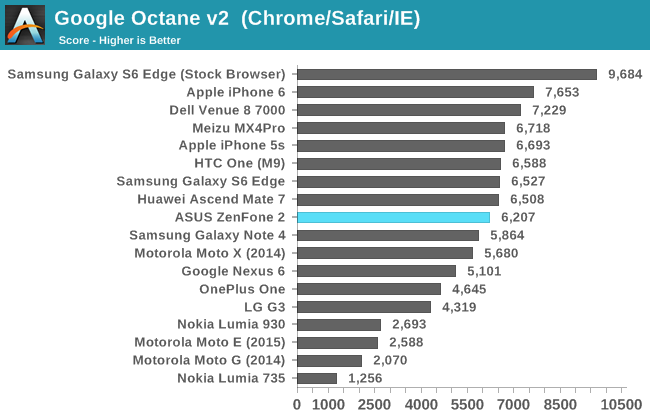
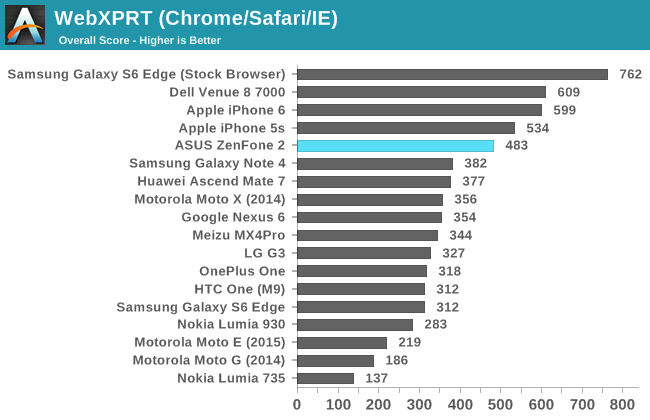
In our web browsing tests the ZenFone 2 performs very well. In the case of Kraken, it does roughly as well as the Venue 8 7000 which uses the same Z3580 SoC. Performance tends to fall behind the Venue 8 in our longer tests like Octane and WebXPRT. I don't have the Venue 8 anymore, but it's a safe bet that this is due to the larger aluminum chassis of the Venue 8 being able to manage heat better in order to keep the clock speeds on the CPU higher during the course of the test.
While the ZenFone 2 isn't quite as fast as a tablet using the same SoC, it's much faster than most of the other devices that we've tested. In general it ends up being a bit slower than the iPhone 5s and the iPhone 6, and of course it loses to the Galaxy S6 using Samsung's browser by an enormous margin in every case. However, a good portion the phones that sit below it are very expensive flagship phones like the Nexus 6, LG G3, and the Galaxy Note 4 which is very impressive for a $300 smartphone.
The next test is Basemark OS II which tests the performance of a device's CPU, GPU, RAM, and NAND.
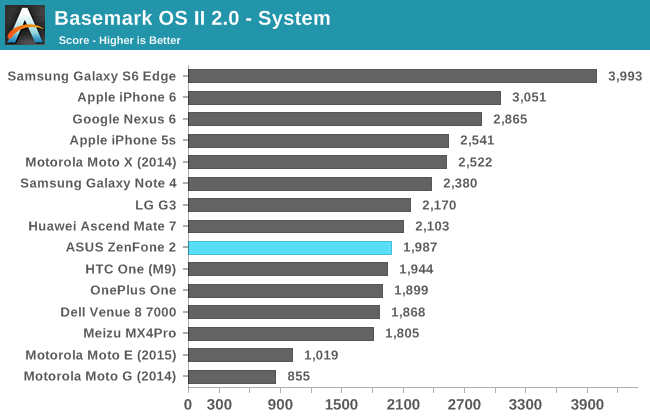
The system sub test performs integer and floating point operations, and also performs some tests like XML parsing. This makes it primarily a test of the device's CPU and RAM. I'm actually somewhat surprised by the ZenFone's performance in this test. By no means is it bad, but I had forgotten that the Venue 8 also struggled to match Snapdragon 801 smartphones in this test.
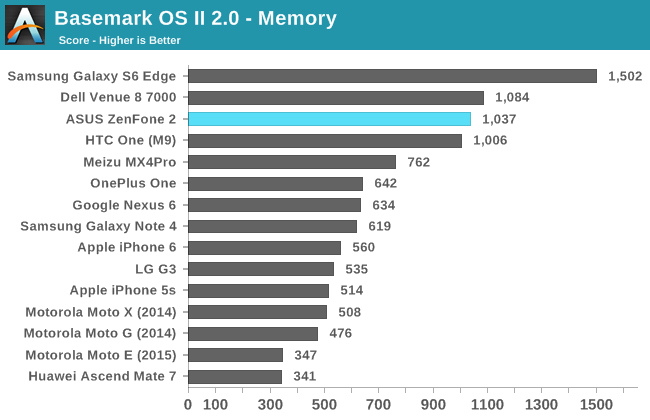
The Basemark OS II memory sub test has a somewhat vague name. While one might expect it to be a test of the device’s RAM, it’s actually a flash storage test. In it we see one of the highest scores of the smartphones we’ve tested, with only the Dell Venue 8 tablet and the Galaxy S6 with its UFS memory achieving higher scores.
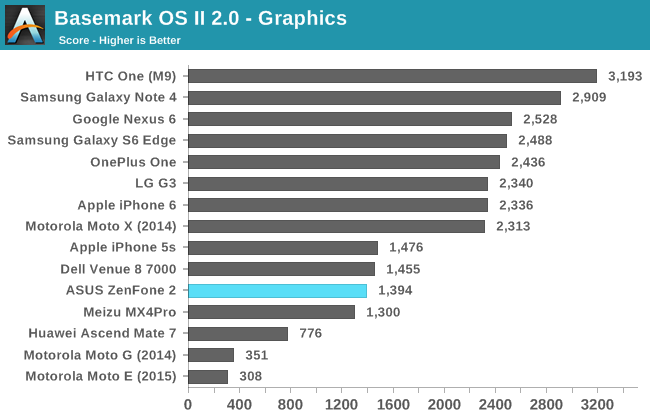
The result in the graphics test is definitely on the lower end of our results, but it’s not unexpected. Both the Venue 8 7000 and the iPhone 5s achieve similar scores, and all three devices use the same G6430 GPU (albeit with lower clock speeds on the iPhone). Even though the ZenFone 2 doesn’t perform as well as the expensive flagship smartphones, it’s far ahead of budget devices like the Moto G. Since both the Z3560 and Z3580 based ZenFone 2 models use the same 533MHz PowerVR G6430 this result should be roughly the same on the $199 model as it is on this $299 model.

The last sub test is the web test. This test focuses on a device’s ability to handle web page rendering, with a focus on HTML5 and CSS rather than Javascript code. In this test we see the ZenFone 2 amongst a large group of devices that includes the HTC One (M9), the Nexus 6, and the Moto X. To see the same level of performance as Snapdragon 805 and 810 devices is very impressive.
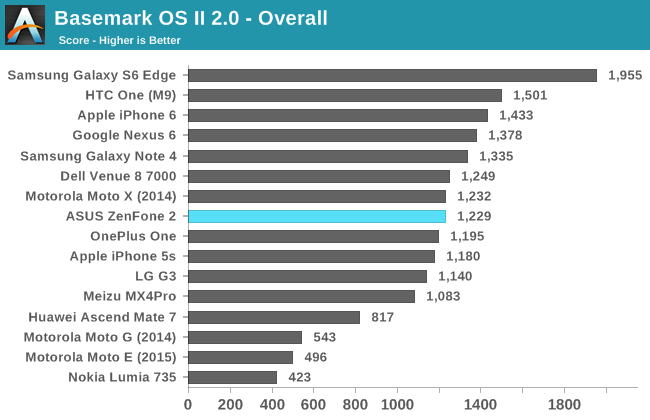
The overall score for BaseMark OS II takes into the account the scores of the various sub tests to generate a final score. In this test we again see the ZenFone 2 around the middle of the pack, with a score that is similar to that of Snapdragon 801 based devices. This is a very good result for a smartphone that costs so little, although the OnePlus One also achieves similar performance at roughly the same price as the $299 model of the ZenFone we are testing.
Our last general performance benchmark is PCMark. This is a relatively new addition to our testing workflow, and it focuses on race to sleep scenarios that reflect the type of usage a device will see in the real world. The tests range from Javascript performance, to playing and seeking in videos, to editing photos.

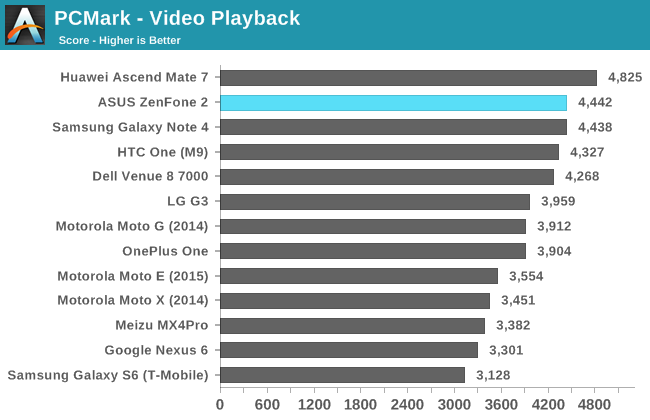
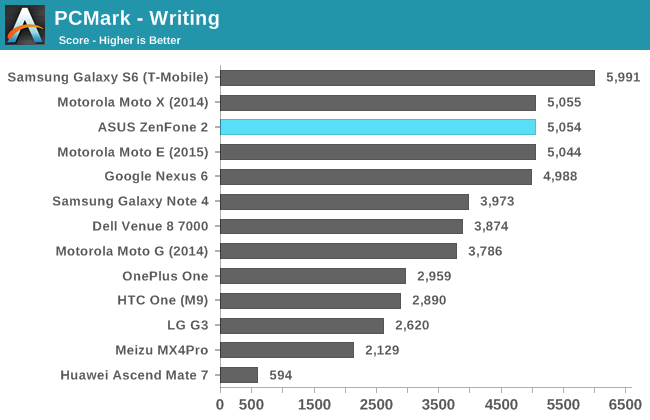
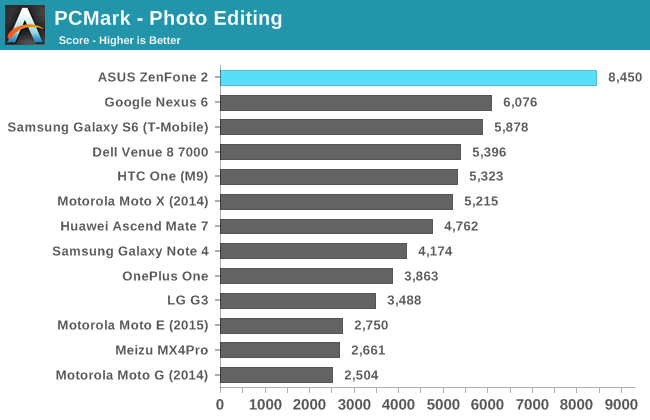
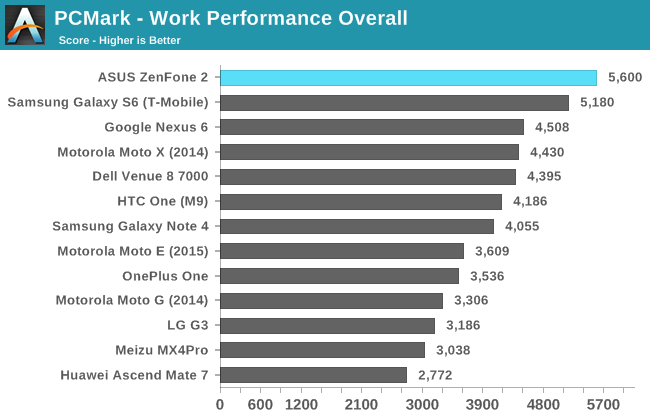
In all of the PCMark sub tests the ZenFone 2 performs extremely well. It’s always at or very close to the top result, and only really loses by a large margin to the Galaxy S6 in the tests that it isn’t right near the top for. The one exception is the photo editing test where it beats every other device by an enormous amount. This score is what carries it to the top position when it comes to the overall score.
I think it’s a bit unfair to say that the ZenFone is the fastest device when it only comes first in a single test, but even without considering the photo editing test it’s clear that the ZenFone 2 offers great performance. Even more amazing is that at times it can trade blows with flagship phones that cost much more than it does. Perhaps due to the fact that it's the only x86 Silvermont-based phone in our benchmarks its relative performance can bounce around versus the competition, but on average it comes rather close to delivering the kind of CPU performance we've seen from the flagship phones over the past year.










147 Comments
View All Comments
der - Tuesday, May 26, 2015 - link
Sweet review mates. Y'all the best!Daniel Egger - Tuesday, May 26, 2015 - link
Two things:1) The x86 problems are very real; about any serious Android application contains native code for performance reasons, the rest are very non-demanding gimmicks or simple games. There're still plenty of application which do not even attempt to run on x86 which can be easily seen by e.g. checking the F-Droid repository with the app. And of those which do run quite a few simply don't work correctly; I've found quite a few of those in the Humble Bundles. My suspicion is that the developers do compile them for x86 but do not really test them on that platform...
2) Those Silvermont cores do have decent performance but I've yet to see a single implementation where battery life doesn't suck. One discovery I've made is that those devices are very reluctant to go into deep sleep, even with some tweaking they'll usually stay on the lowest possible frequency most of the time. Could be that the software is not quite ready to properly handle those Intel cores or they simply suck...
MikhailT - Tuesday, May 26, 2015 - link
Both are software issues. Google doesn't have any incentives to stick with ARM only, they'd want to work with Intel to fix these issues.At my work, we had an issue where our app would crash on Intel devices, it took us a few weeks to figure out that it was a low-level bug in Android. We filed a bug report but no news if Google or Intel will fix it. We managed to work around it but it was difficult and took a lot of time.
The latest rumors is that Android M is supposed to work on the battery issues. Hopefully, that includes optimization for Intel SoCs.
kpb321 - Tuesday, May 26, 2015 - link
I was surprised that the review seemed to skip this entirely. It is certainly an issue when dealing with x86 android phones. Theoretically any app that doesn't include NDK "should" work fine on x86. My experience with Android phones/tablets was that I don't ever recall installing a single app that had NDK in the permissions list so it didn't seem like it was very common to me. On the other hand I've never actually had an intel tablet to actually see how good or bad it was.Brandon Chester - Tuesday, May 26, 2015 - link
I also reviewed the Venue 8, and like I said in both this review and that review, I have never found a single app that doesn't work because the SoC is x86. A lot of people like to say that there are lots of apps that have issues, but they never seem to name any so there's no way for me to actually confirm that. If people do know of some problematic apps please let me know via email or Twitter so I can take a look.Muyoso - Tuesday, May 26, 2015 - link
An app called Photo direct that I use for work crashes instantly when launched.rocketbuddha - Wednesday, May 27, 2015 - link
I bought a Dell Venue 8 with KitKathttp://www.bestbuy.com/site/dell-venue-8-8-intel-a...
and found that it was the POS.
Dunno if it was 1GB RAM that came with it, but it was hanging even while opening tabs in chrome/stock browser.
With Lollipop, Google officially has both a ARM as well as x86 version it tests and releases. Pre-lollipop it was Intel who customized Android to work with its Atom processors.
Maleficum - Saturday, May 30, 2015 - link
Brandon, you'd be really surprised to know that most apps in the top charts are using NDK.Google claims that 85% apps are written in Java. I'm not saying it's a lie, but it is far from realistic since most apps in the top charts - apps most people use most of their time - are NDK based.
Even more surprising would be the fact that roughly half of these apps contain ARM binaries only, thus forced to run via binary translation that results in a performance reduction of roughly 70% while the power consupmtion doubles.
In that sense, your article is misleading IMHO, simply repeating Google's claims.
http://www.theregister.co.uk/2014/05/02/arm_test_r...
I think it's clear why so many apps are NDK based: Java isn't simply the right language for computationally intensive apps, and primitive apps written in Java cannot make it into the top charts.
And app developers aren't interested much in supporting x86 natively considering the tiny market share. No one can blame them for neglecting x86.
That's the reason why I'd never buy nor recommend x86 Android phones, and Intel having difficulties getting foothold in mobile segment.
I think it would be worth an investigation and probably a separate article.
Thunderc8 - Saturday, May 30, 2015 - link
I have installed all known apps and then some and all working perfect and super fast. If what you say is true then Intel CPU is a beast since it looses so much performance and at the same time is so Damn fast.coolied - Wednesday, May 27, 2015 - link
NDK wouldn't be in the permissions list, it simply means the app was coded in C++ and not JAVA. Unfortunately, most apps you would WANT to run and run WELL are written in C++ aka most 3D games.